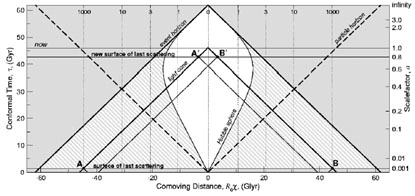


4.3. Horizon problem
What should our assumptions be about regions of the Universe that have never been in causal contact? If we look as far away as we can in one direction and as far away as we can in the other direction we can ask the question, have those two points (points A and B in Fig. 4) been able to see each other. In the standard big bang model without inflation the answer is no. Their past light cones are the little cones beneath points A and B. Inserting a period of inflation during the early universe has the effect of moving the surface of last scattering up to the line labeled "new surface of last scattering". Points A and B then become points A' and B'. And the apexes of their past light cones are at points A' and B'. These two new light cones have a large degree of intersection. There would have been sufficient time for thermal equilibrium to be established between these two points. Thus, the answer to the question: "Why are two points in opposite sides of the sky at the same temperature?" is, because they have been in causal contact and have reached thermal equilibrium.
 |
Figure 4. Inflation shifts the position of
the surface of last scattering. Here we
have modified the lower panel of
Fig. 1 to show what the
insertion of an early
period of inflation does to the past light cones of two points,
A and B, at the
surface of last scattering on opposite sides of the sky.
An opaque wall of electrons - the cosmic photosphere, also known as the
surface of last scattering - is at a scale factor
a = R / Ro
|
 |
Figure 5. |
Five years ago most of us thought that as we waited patiently we would
be rewarded with
a view of more and more of the Universe and eventually, we hoped to see
the full extent of the inflationary bubble -
the size of the patch that inflated to form our Universe. However,
 has interrupted
these dreams of unfettered empiricism.
We now think there is an upper limit to the comoving size of the
observable universe.
In Fig. 4 we see that the observable universe
(= particle horizon) in the new
standard
has interrupted
these dreams of unfettered empiricism.
We now think there is an upper limit to the comoving size of the
observable universe.
In Fig. 4 we see that the observable universe
(= particle horizon) in the new
standard  -CDM
model approaches 62 billion light years in radius but will never extend
further. That is as large as it gets. That is as far as we will ever be
able to see. Too bad.
-CDM
model approaches 62 billion light years in radius but will never extend
further. That is as large as it gets. That is as far as we will ever be
able to see. Too bad.